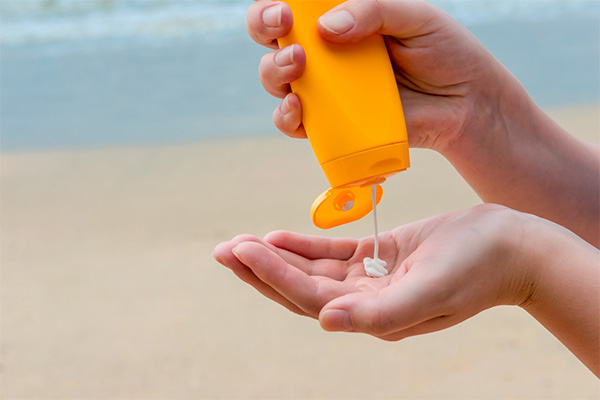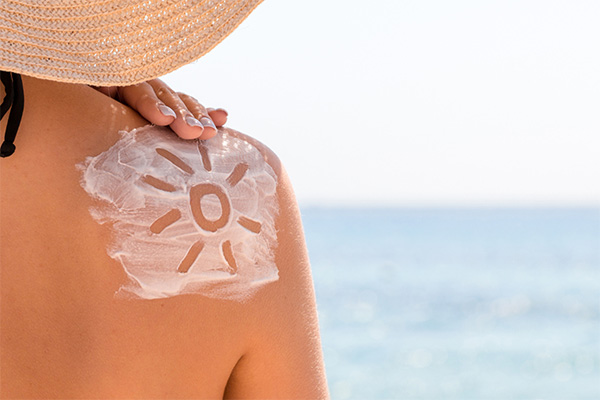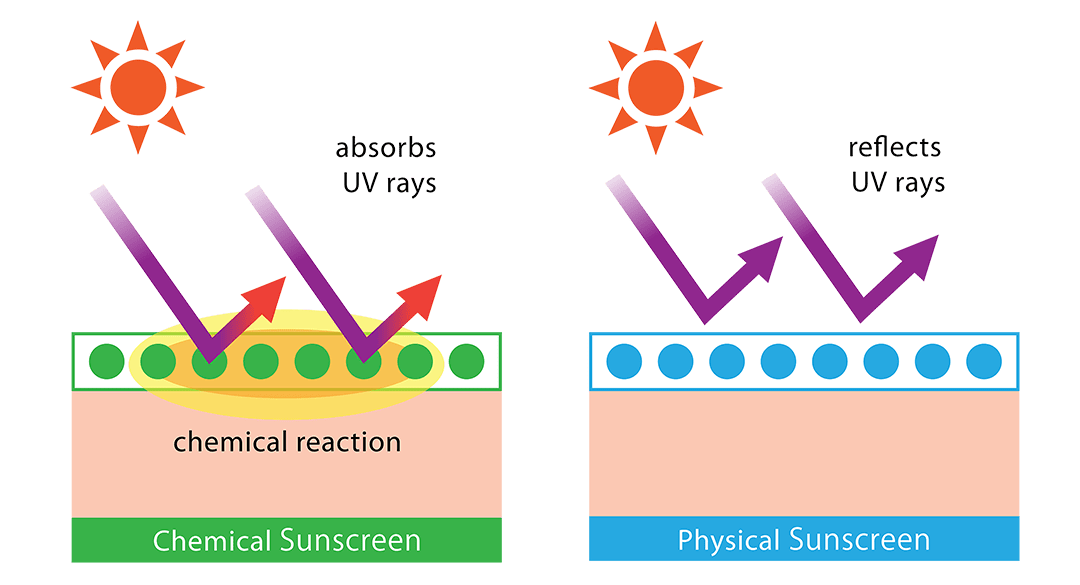We all know it is important to wear sunscreen because ultraviolet rays from the sun can cause significant skin damage! Nevertheless, when faced with selecting a sunscreen, the sheer number of choices available can indeed feel overwhelming! There are shelves full of both chemical and mineral sunscreens, each labeled with different SPF ratings and active ingredients. Is one better than the other? Should you choose mineral or chemical sunscreen? How do you know which to choose?
Don't fret, we've got you covered. Below, we'll explain what sunscreens do, how both chemical and mineral sunscreen provide protection in different ways, and the pros and cons of each.
How Sunscreens Work
All chemical and mineral sunscreen sunscreens prevent ultraviolet rays from the sun from penetrating your skin and causing damage. Sunscreens either use chemical filters to help absorb and deflect the ultraviolet (UV) rays or use various mineral filters as a physical barrier against these rays.
Types Of Ultraviolet Rays
The sun emits more than one type of UV ray, each of which can cause skin damage in different ways.
UVA Rays - Ultraviolet A rays have a long wavelength, enabling them to penetrate deeply into the skin. UVA rays specifically are what cause long-term skin damage, such as skin cancer, age spots, and wrinkling.
UVB Rays - Ultraviolet B (UVB) rays possess a shorter wavelength and impact solely the outermost layer of the skin. Although the effects of UVB ray damage are less long-lasting, they can cause tanning, discoloration, and painful sunburns.
Sunlight contains approximately 500 times more UVA rays than UVB rays, so it's important to remember that your sunscreen choice needs to do more than just deter sunburns! Blocking UVB rays alone is not enough to avoid the damage caused by the sun's UV rays.
SPF Ratings
The Sun Protection Factor, or SPF, is the universal rating system employed for all categories of sunscreen. This number, typically printed prominently on the bottle or tube of sunscreen, tells you how many times a specific sunscreen will protect you from redness caused by UVB rays compared to not wearing sunscreen at all.
Firstly, SPF measures the ideal use of sunscreen, including proper application and no exposure to any elements that would wash it away. Many of us apply sunscreen haphazardly and either jump into water or sweat - two things that can wash off the sunscreen! For this reason, it's recommended to reapply sunscreen every two hours at minimum, regardless of the sunscreen's SPF.
Furthermore, SPF exclusively gauges safeguarding against UVB rays. It says nothing about protection against UVA rays at all! Remember, UVA rays are the sun's most damaging rays, as they penetrate the deepest into the skin. We want to prevent more than just sunburn! Shielding against both UVA and UVB rays is essential to prevent skin cancer.
Chemical Sunscreen

Chemical sunscreens, also known as organic sunscreens, are a type of sun protection that works by absorbing and dissipating ultraviolet (UV) radiation from the sun. They contain organic (carbon-based) compounds that undergo a chemical reaction upon exposure to UV rays, converting the energy into less harmful forms, such as heat. These chemical compounds are commonly denoted as the "active ingredients" within the sunscreen formulation. These active ingredients commonly include:
- Octocrylene
- Homosalate
- Avobenzone
- Oxybenzone
- Octinoxate
- Octisalate
These chemical sunscreens absorb sun rays and dissipate them through chemical reactions. This prevents the rays from making contact with your skin. However, to offer effective sun protection, the skin must first absorb these chemicals. Only after being absorbed by the skin can they then do the work of dissipating UV rays.
All of these chemicals have been approved for topical use by the Food and Drug Administration. However, some studies have found potential risks for many of these compounds. Although the research is inconclusive, these studies show a correlation between the chemical ingredients in sunscreens and a rise in hormonal and reproductive issues in adults.
Furthermore, as chemical sunscreens are designed to be absorbed into the skin, they also enter the bloodstream. Pregnant and nursing mothers should be aware of the risk of passing on these chemicals through their placenta and breast milk.
Benefits Of Chemical Sunscreens

- Chemical sunscreens tend to be easier to use. They easily spread into the skin, making them quick and easy to apply.
- Chemical sunscreens do not result in a white residue on the skin.
- Chemical sunscreens are available in a diverse array of formulations, such as lotions, creams, sprays, and gels. This assortment empowers users to select a product that aligns with their preferences and skin type.
Risks Of Chemical Sunscreens
- People with sensitive skin may present with a rash as the chemicals are absorbed into their skin.
- Chemical sunscreen washes off more easily than physical sunscreen, creating the need to reapply it more frequently throughout the day.
- Chemical sunscreens require a period to be fully absorbed by the skin and attain effectiveness. Applying most chemical sunscreen components 20 to 30 minutes before sun exposure is essential to avert skin damage.
- Certain chemical sunscreen ingredients, particularly oxybenzone and octinoxate, have been linked to coral reef damage. To safeguard marine ecosystems, certain areas have enforced bans or limitations on these ingredients.
- There has been debate about the extent to which certain chemical sunscreen ingredients are absorbed into the bloodstream and their potential effects on health.
Mineral Sunscreen

Mineral sunscreens, alternatively labeled as physical sunscreens or mineral-based sunscreens, operate by establishing a tangible shield on the skin's outer layer. This shield reflects and disperses ultraviolet (UV) radiation emitted by the sun. These sunscreens employ minerals like zinc oxide and titanium dioxide as their active constituents, ensuring comprehensive defense against both UVA and UVB rays. The two minerals used as active ingredients are:
- Zinc Oxide
- Titanium Dioxide
These minerals sit on top of the skin and provide a physical screen that reflects the sun's rays rather than dissipating them through chemical reactions. They don't need to be absorbed into the skin and are intended to sit on top of its surface. They offer broad spectrum protection, reflecting both types of the sun's damaging UV rays.
Some sunscreen manufacturers have claimed that since the zinc oxide and titanium oxide particles are broken down into small pieces, they could seep into the skin cells and cause similar concerns as chemical sunscreens. Manufacturers with this concern will label their products as "non-nano," meaning that they include no nanoparticles of zinc oxide and titanium dioxide.
Nano-sized particles have the potential to enter the bloodstream, whereas non-nano particles do not possess this capability. Consequently, non-nano sunscreens are generally perceived as safer unless the brand has treated its nanoparticles to render them non-reactive and entirely safe.
Nevertheless, caution is warranted when considering nanoparticle coating, as it could diminish sunscreen effectiveness and potentially lead to prolonged health implications for individuals while also being detrimental to the environment.
Benefits Of Mineral Sunscreens

Mineral sunscreens work through the formation of a tangible barrier on the skin's outer layer, which then reflects and disperses UV radiation. This mechanism offers immediate sun protection upon application.
- Most mineral sunscreens offer immediate protection against the sun's damaging rays since there are no sunscreen chemicals to absorb before effective production is offered.
- Mineral sunscreens are naturally broad-spectrum sunscreens that block rays of both UV radiation types.
- Titanium dioxide and zinc oxide have been proven safe. They sit on the skin and are not absorbed into the body.
- The active ingredients in mineral sunscreens, usually zinc oxide and titanium dioxide, are considered less likely to cause allergic reactions compared to some chemical sunscreen ingredients.
- Mineral sunscreens are generally considered more environmentally safe than specific chemical sunscreen ingredients associated with coral reef harm. They don't contribute to the same level of ecosystem harm.
Risks Of Mineral Sunscreens
- Mineral sunscreens' physical formulas leave a white cast and a residue on the skin that may feel heavy and difficult to blend in.
- Mineral formulas are thick, and applying a thorough layer of sunscreen on the body requires more product.
- Mineral sunscreens can be more prone to rubbing off or sweating off, which may reduce their effectiveness over time. Consistent reapplication is crucial, particularly following swimming or perspiring.
- Some mineral sunscreens are less water-resistant than chemical sunscreens, which can concern individuals engaging in water activities.
Chemical Vs. Mineral Sunscreen: Which Should You Choose?

Image Source: Pexels
Both mineral and chemical sunscreens have pros and cons that users should consider when deciding which to use. Most health-conscious individuals generally opt to use mineral sunscreen over chemical sunscreen for many reasons.
Mineral sunscreen ingredients offer broad-spectrum sun protection, protecting against both sunburns (UVB rays) and skin cancer (UVA rays). Although the FDA has deemed chemical sunscreens safe, recent studies call this into question, and these potential concerns can be avoided altogether by simply opting for a mineral sunscreen instead.
While the potential for a white cast and slightly thicker texture are factors to consider, the skincare industry's progress in developing improved formulations addresses these concerns. Modern mineral sunscreens are increasingly designed to minimize the white cast and provide a smoother application experience.
Ultimately, choosing mineral sunscreen over chemical sunscreen underscores your commitment to immediate protection, skin sensitivity, and environmental well-being. By opting for mineral sunscreen, you choose a safer, gentler, and more responsible approach to safeguarding your skin and the world around you.
Remember that sun protection is paramount, regardless of the sunscreen type, and finding the right fit for your preferences is key to maintaining healthy skin and a sustainable lifestyle.

